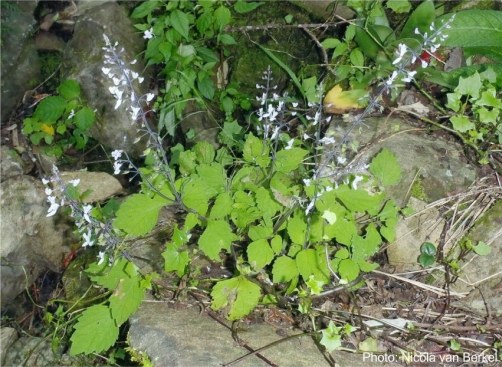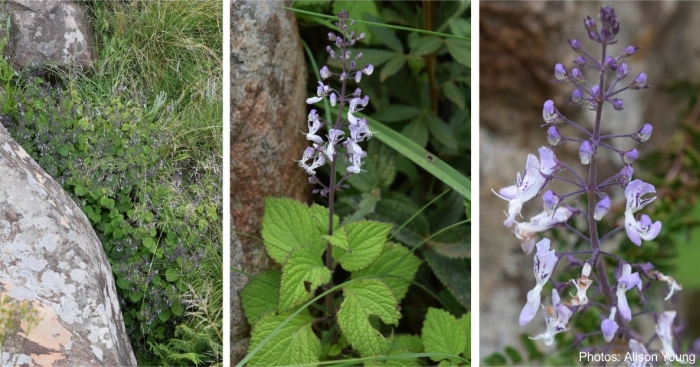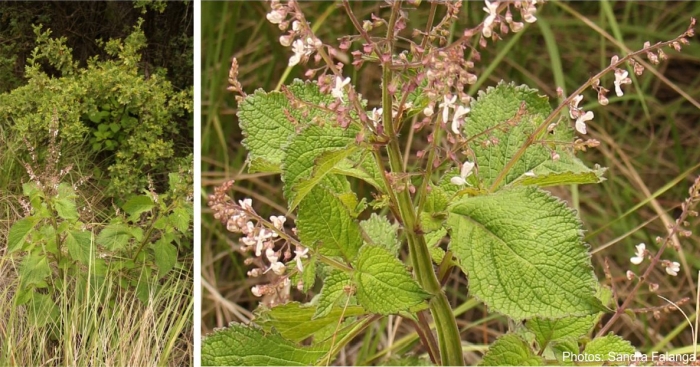Plectranthus grallatus
Plectranthus grallatus Briq.
Family: Lamiaceae
Common names: Drakensberg spurflower, tuberous spurflower (Eng.); Drakensberg spoorsalie, knolspoorsalie (Afr.); umnyamawempunzi (isiZulu)
Introduction
An herbaceous shrub, that resprouts annually from underground tuberous stems, with large, decorative, soft leaves and white flowers in late summer; easy to grow in well-watered, light shade and frost hardy.

Description
Description
Plectranthus grallatus is a soft-wooded, herbaceous, sparsely branched shrub, 0.2–1.5 m tall, with underground tuberous stems, spreading vegetatively. Aerial stems, which are produced every year, are fleshy, erect to reclining, finely hairy with purple hair at the nodes. Leaves are broadly ovate, smooth, or rough, with reddish brown gland dots underneath. Flowers are white flushed with pink, speckled with a few purple spots on the upper lip, in a branched terminal inflorescence, 100-260 mm long. Flowering is in midsummer to autumn (December to May) with a peak in February.

Plectranthus grallatus is related to P. fruticosus and P. oribiensis, however P. fruticosus can be differentiated by its perennial stems which are basally woody and its mauve to pink corolla, and P. oribiensis by its cordate leaves, hollow stems and hairy mauve corolla.
Conservation Status
Status
Plectranthus grallatus is not threatened and is thus assessed as a species of Least Concern (LC) on the Red List of South African Plants.
Distribution and habitat
Distribution description
Plectranthus grallatus is usually found at high altitudes (1 300 up to 3 000 m) in Afromontane Forest, where it grows on forest floors and on forest margins, along streams, in rocky places, and in shady areas, often where the soil is permanently damp during summer. Distribution ranges from Cathcart in the Eastern Cape through KwaZulu-Natal and Mpumalanga to Limpopo Province, it also thrives in Gauteng and Free State, and occurs in Lesotho and Eswatini. In the wild, it often produces aerial tubers in the leaf axils.

Derivation of name and historical aspects
History
The Latin species name is derived from grallator, meaning ‘a stilt-walker’, maybe referring to the leaf hairs, or to the rod-like, stilted stems. Plectranthus grallatus was first collected by Rudolph Schlechter at Mount-Frere and was introduced to Kirstenbosch National Botanical Garden in 1976.
Species of Plectranthus can be confused with species of Coleus or Thorncroftia, which are also succulent or semi-succulent, soft, herbaceous shrubs, in the Lamiaceae.

Ecology
Ecology
Plectranthus grallatus is usually found growing in the wild, at high altitude in the Drakensberg Mountains, where frost is often severe. When its top growth gets frosted, it merely drops its aerial parts, goes dormant and sprouts again from the underground tubers. Flowers are pollinated by insects; mosquitoes have been noticed feeding on the nectar, the flowers also attract insects such as honeybees, butterflies, carpenter bees and bombyliid flies.

Uses
Use
Plectranthus grallatus is an ideal ornamental plant for shady areas in large or small gardens and it is suitable for cold highveld gardens or warm, coastal gardens. Roots are used in traditional medicine.

Growing Plectranthus grallatus
Grow
Propagation of Plectranthus grallatus can easily be done by 2 methods, either by sowing seeds or taking cuttings, most preferably in spring or summer.
Sow seeds in a well-drained soil mix, cover lightly with a thin layer of sand, and put in a warm but shaded area. Germination will start in about 2 or 3 weeks.
Cuttings of Plectranthus grallatus root easily, if taken with good care; soft-wood tips root quicker than semi-hardwood growth. The cuttings are best taken at 60 to 100 mm long with 3 or 4 nodes, and the cut needs to be made just below a node. Put them in a sandy cuttings mixture, keep them moist and shaded and they should root in 2 to 3 weeks.
Plant Plectranthus grallatus in a moist position in light shade, such as in a cool forest garden.
References
- Cole, B. 2019. Observation of Plectranthus grallatus, Ongeluksnek Wildlife Reserve, KwaZulu-Natal. iNaturalist. Online. https://www.inaturalist.org/observations/19723964.
- Falanga, S. 2020. Observation of Plectranthus grallatus, Golden Gate National Park, Free State. iNaturalist. Online. https://www.inaturalist.org/observations/41029888.
- Foden, W. & Potter, L. 2005. Plectranthus grallatus Briq. National Assessment: Red List of South African Plants version 2020.1. Accessed on 2022/08/06.
- Hutchings, A., Scott, A.H., Lewis, G. & Cunningham, A.B. 1996. Zulu medicinal plants: an inventory. University of Natal Press, Pietermaritzburg.
- Ogle, C. 2012. Observation of Plectranthus grallatus, Drakensberg, KwaZulu-Natal. iNaturalist. Online. https://www.inaturalist.org/observations/93429640.
- Pooley, E. 1998. A field guide to wild flowers Kwazulu-Natal and the eastern region. Natal Flora Publications Trust, Durban.
- Pooley, E. 2003. Mountain flowers, a field guide to the flora of the Drakensberg and Lesotho. Natal Flora Publications Trust, Durban.
- Van Berkel, N. 2014. Observation of Plectranthus grallatus, Hogsback, Eastern Cape. iNaturalist. Online. https://www.inaturalist.org/observations/10948688.
- Van Jaarsveld, E. 2006. The southern African Plectranthus and the art of turning shade to glade. Fernwood Press, Vlaeberg, Cape Town.
- Young, A. 2019. Observation of Plectranthus grallatus, Ntsikeni Nature Reserve, KwaZulu-Natal. iNaturalist. Online. https://www.inaturalist.org/observations/20298452.
Credits
Stemmer Ngalo
Free State National Botanical Garden
September 2022
Acknowledgements: the author thanks Brendan Cole, Colin Ogle, Alison Young and Sandra Falanga for making their images available via iNaturalist.
Plant Attributes:
Plant Type: Perennial, Shrub
SA Distribution: Eastern Cape, Free State, Gauteng, KwaZulu-Natal, Limpopo, Mpumalanga
Soil type: Loam
Flowering season: Late Summer, Autumn
PH:
Flower colour: Purple, White, Pink, Mauve/Lilac
Aspect: Shade, Morning Sun (Semi Shade), Afternoon Sun (Semi Shade)
Gardening skill: Easy
Special Features:
Horticultural zones









Rate this article
Article well written and informative
Rate this plant
Is this an interesting plant?
Login to add your Comment
Back to topNot registered yet? Click here to register.